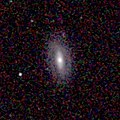| NGC 434 | |
|---|---|
 NGC 434 (right side, lower galaxy) and NGC 434A (right side, upper galaxy) as seen by legacy surveys. At the lower left side is NGC 440. | |
| Observation data (J2000 epoch) | |
| Constellation | Tucana |
| Right ascension | 01h 12m 14.1s [1] |
| Declination | −58° 14′ 53″ [1] |
| Redshift | 0.016425 [1] |
| Heliocentric radial velocity | 4,924 km/s [1] |
| Apparent magnitude (V) | 12.79 [1] |
| Absolute magnitude (V) | -22.58 [1] |
| Characteristics | |
| Type | SAB(s)ab [1] |
| Apparent size (V) | 2.1' × 1.2' [1] |
| Other designations | |
| ESO 113- G 023, 2MASX J01121411-5814525, ESO-LV 1130230, PGC 4325. [1] | |
NGC 434 is an intermediate spiral galaxy of type SAB(s)ab located in the constellation Tucana. It was discovered on October 28, 1834 by John Herschel. It was described by Dreyer as "bright, small, round, pretty suddenly bright middle." [2]

